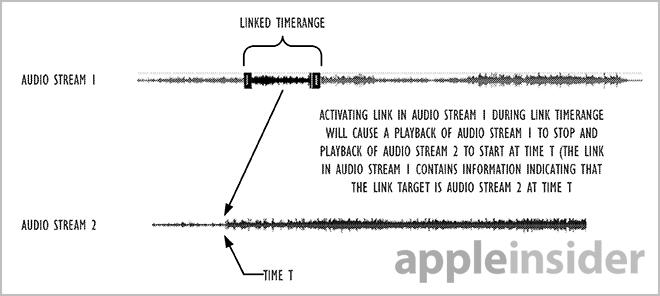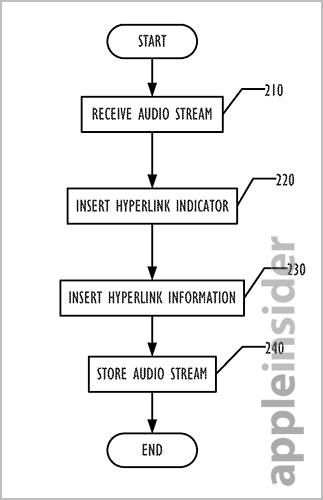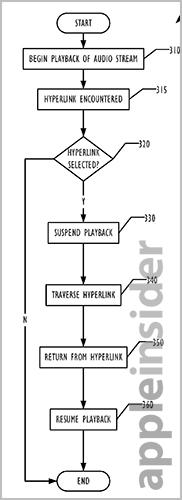Apple's 'audio hyperlink' tech can control devices with inaudible sonic pulses
An Apple patent filing published by the U.S. Patent and Trademark Office on Thursday describes a method of encoding hyperlinks into an audio stream, offering content creators the ability to link to other media, or control a device's user interface, with a song or podcast.
Titled "Audio Hyperlinking," Apple's invention is similar in function to the current "enhanced podcast" technique used to add images, URLs and other content to a file encoded in the AAC audio format. Instead of wrapping the assets as chapter markers or metadata, however, the invention's hyperlinks are encoded directly into the source audio stream.
From the patent filing's background:
For example, many podcast programs identify other resources that might be of interest to the listener, such as other podcasts or web material, there is currently no way for a podcast to provide a hyperlink to such other resources in the audio content of the podcast.
In one embodiment, a hyperlink indicator and accompanying instruction set can be embedded in the audio stream as either an audible or inaudible tone. As noted in the application, these tones can be grouped into sequences that are detected and decoded by the playback framework.
Once the audio hyperlink is identified, the device "traverses" the hyperlink based on information provided in the decoded data to change its user interface, displaying information about the link, notify the listener of its presence, or take any other action as instructed. Some embodiments don't require user input, meaning the device will execute instructions based on predetermined settings or preferences.
Certain hyperlinks can pause currently playing audio and take the listener to another position in the track, to another media file, or a Web content. Alternatively, the hyperlink can lead to images, URLs and other media. Basically, the audio hyperlink acts as a traditional text-based hyperlink, but is encoded in audio data.
A decaying pulse amplitude can also be applied to limit the time in which a hyperlink is active. In this case, a user may have to touch the device's screen, use voice commands, or interact with physical buttons to follow the link. Once the signal reaches a certain threshold, the hyperlink becomes inaccessible.
The filing notes that, like enhanced podcasts, audio hyperlinks can be accompanied by markers that notate their location on the track. This data would not be interleaved with the audio stream, but may be stored as associated metadata instead.
Solutions similar to Apple's described invention are already in use, though only specialized programs can take advantage of the technology. For example, during a recent concert tour, Lady Gaga performed a song that included inaudible tones only electronic devices can distinguish. An accompanying service called Sonic Notify translated those high frequency tones into a type of hyperlink that led smartphones to webpages and images.
It is unclear what Apple has planned for the invention, but such technology can theoretically be applied to songs with rich interactive content, or for ad placement in tracks played via the forthcoming iTunes Radio.
Apple's audio hyperlink patent application was first filed for in 2012 and credits Samir Gehani as its inventor.
 Mikey Campbell
Mikey Campbell













 Wesley Hilliard
Wesley Hilliard
 Andrew Orr
Andrew Orr



 Amber Neely
Amber Neely

 William Gallagher
William Gallagher







